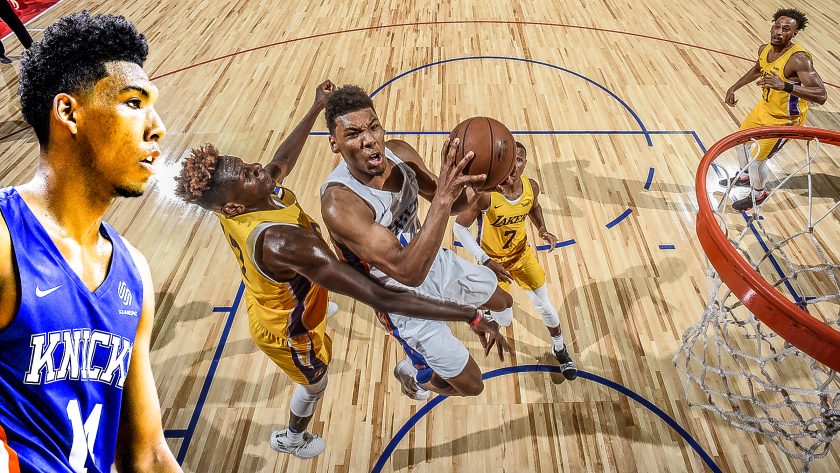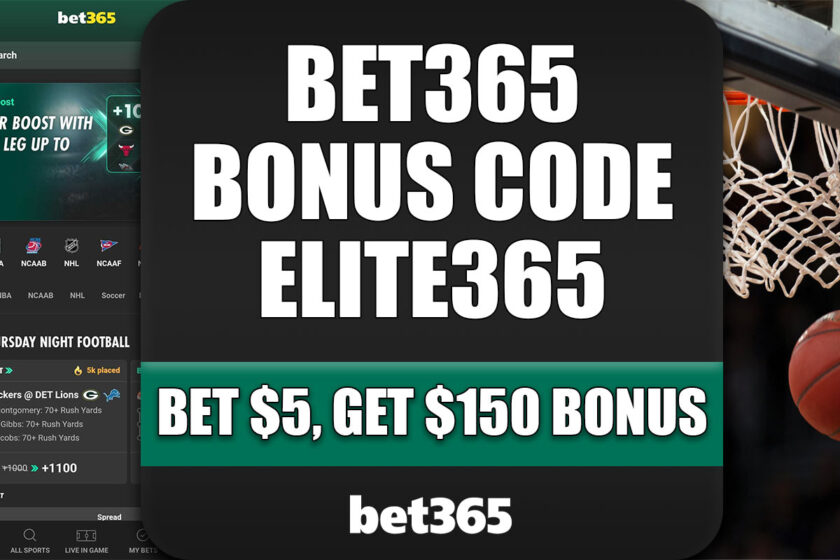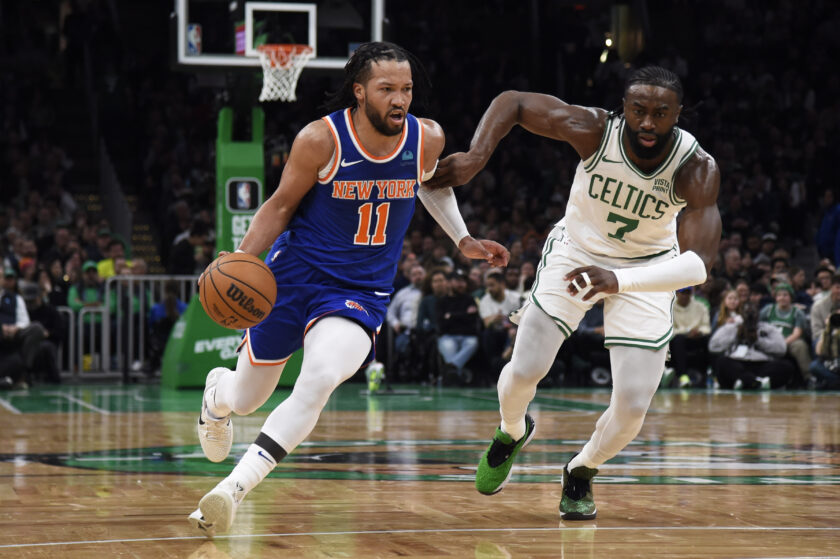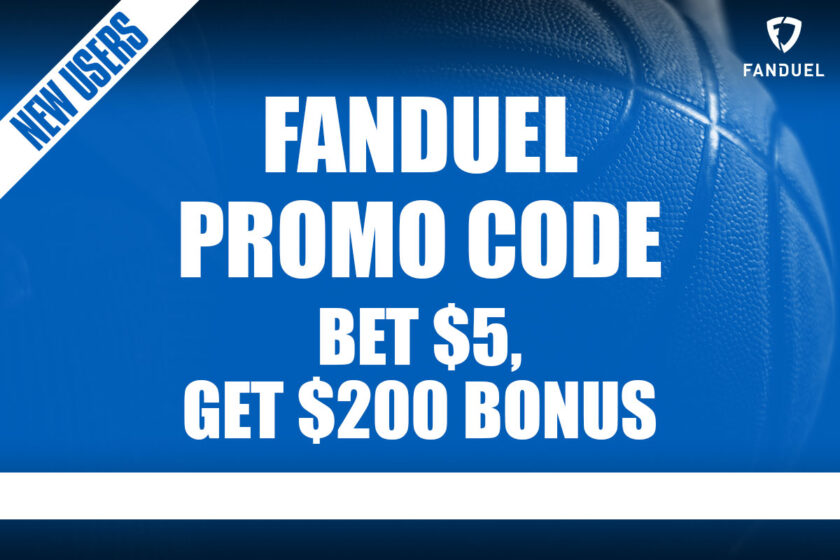New York Knicks: 3 goals for Allonzo Trier this season

Allonzo Trier may have a future with the New York Knicks, but while he’s on a two-way deal, he must focus on these three aspects of his game.
Allonzo Trier is on a two-way contract with the New York Knicks. The young guard has an opportunity to prove his worth, albeit mostly in the G League, but there’s no doubt that he can play his way into David Fizdale’s future plans. To do so, he must focus on three key aspects of his game.
But before we discuss the upcoming season, it’s important to look back at how Trier ended up in New York and what the future of the Knicks’ backcourt looks like. This can help bring context to the idea that Trier isn’t your average player on a two-way contract.
During the pre-draft process, there was a mutual interest between Trier and the Knicks. In fact, Trier thought the Knicks would select him with the 36th pick in the draft. Trier said via the Daily Wildcat:
“But even before I worked out for them, we were in real communication with them, and we really thought I was going to be the pick at 36. It was looking like that was what was going to happen, and then a guy like Mitch Robinson falls to 36 and the priority for the team was ‘big first’ so they went with him. Totally understandable.”
The funny thing is, the Knicks didn’t have another pick in the draft, but the two sides didn’t let that get in the way. According to the Daily Wildcat, Trier said:
“And then I had a chance to be picked from about 41 and on and they were all places that I didn’t think were a great fit, so we turned down pretty much everybody after that and decided that we were going to go with the Knicks because it was the best fit for me in the first place.”
Trier passed up on the opportunity to hear his name called in the draft for the opportunity to come to New York. Clearly, he wants to be here, but how much opportunity does he have on his current two-way contract? After all, he can only spend 45 days on the NBA roster. He’ll be spending a lot of time with Mike Miller and the Westchester Knicks.
But that’s fine. This gives the organization time to develop him into the player they want him to be while freeing up space on the NBA roster to give a few guys their final tryout.
[sc name=”Knicks Center”]Frank Ntilikina is the only guard on the roster that the Knicks are seriously committed to long-term. Trey Burke showed positive signs last season, but he’ll need to prove that his impressive shooting was no fluke. Not to mention, he’s a liability on defense, in part because of his size. Emmanuel Mudiay will have another year to audition, but no one expects much from this former lottery pick. There’s no significant investment in Damyean Dotson. He’s more or less dispensible at this point, but he’ll have a chance to prove his worth this season as well.
Courtney Lee will almost certainly be gone by the trading deadline — if not sooner. The Knicks committed big money to Tim Hardaway Jr., but he’s another veteran whose future could be elsewhere. If the Knicks can find a team willing to make a deal for THJ, they may make a move and look to spend that money elsewhere. Don’t forget about the $4.5 million man, Ron Baker. He’s a restricted free agent at the end of the year and who knows what his future holds under the current regime.
Long story short: the Knicks backcourt could see significant turnover in the next 12 months. Trier has just as much of a chance as anyone else on the current roster to carve out a spot in the rotation for the 2019-20 season.
So what does Trier need to do in Westchester to ensure that he has a future in Madison Square Garden? Here are three goals for Trier’s upcoming season.
[sc name=”Knicks Title” text=”Develop into a legitimate point guard” ]Trier’s future in the league is as a combo guard — someone that can flex as the primary ballhandler or play off the ball as a true shooting guard. At 6-foot-5, Trier is tall enough to play shooting guard, but with a 6-foot-6 wingspan, he’s undersized at the small forward position. This forces his hand into becoming that flexible option who can run the team as the point guard or slide in as a two guard with scoring touch.
Trier’s calling card has always been scoring, but his decision making has always been more of a question mark. He’ll need to show that he can succeed as the point guard if he wants any future in the league. He has a good handle, but there’s more to running the show.
Let’s take a look at this play from the Knicks first game at Las Vegas Summer League against the Atlanta Hawks below. Trier does well to push the ball in transition and attack, putting pressure on the defense. He shows off his handle with a nice crossover and takes a contested jumper.
But that’s not the best shot Trier could have gotten. Once he makes that crossover, he has his defender beat if he drives to the basket. He likely saw the clogged lane and decided his best option was to shoot the 20-footer. However, if Trier attacked Hawks’ big man, John Collins in the lane, he would have had the freakishly athletic, Mitchell Robinson in a dangerous position under the rim or Damyean Dotson sprinting out to the corner for a three.
This is something that Trier needs to work on in the G League. Sometimes he’ll need to think pass first, which goes against his nature as a bonafide scorer. But he must recognize that attacking the lane and finding the open man is preferable to settling for an inefficient shot from the mid-range.
His development as a point guard could make or break his future with the Knicks.
[sc name=”Knicks Title” text=”Prove his scoring ability” ]Trier’s best asset is his ability to put the ball in the bucket. If he can’t do that, he won’t have a long career in the NBA. Plain and simple. No doubt, there are other aspects of his game that need more work, but he needs to prove he can score the ball. He has a quick first step (as evidenced in the video above), he can get hot from the outside at any time, and he knows how to go to the free throw line.
He can be a streaky shooter at times, but he’s a good shooter that just needs to develop more consistency. The University of Arizona product can score in a variety of ways and he did that extremely well in college. But now it’s time to prove that his scoring ability translates to the next level.
[sc name=”Knicks Title” text=”Defend, defend, defend” ]This could be a blanket statement for any young player on the Knicks. David Fizdale has made it clear that he values tough, rugged players who want to defend. The quickest way to catch the eye of the new head coach may be with a dogged defensive mentality.
He’s athletic enough to become a good on-ball defender, but almost everything about his defense needs to improve. He needs to increase his awareness off the ball, improve his ability to guard one-on-one on the perimeter, and work on forcing more turnovers. But if he’s a competitor, he has all the physical tools to improve.
It also doesn’t hurt that he’ll be playing a majority of his games in Westchester where he can focus on improving this aspect of his game. There isn’t much pressure on him to put it all together right away. He’ll have time to make mistakes and suffer through growing pains. That’s just part of the process when you’re on a two-way contract.
The G League is mostly about developing role players. If Trier can utilize his time in Westchester to develop into an offensively gifted combo guard and a competent defender, he may have a long-term future in New York. If not, he won’t stick around here long.
[sc name=”Knicks Link Next” link=”https://elitesportsny.com/2018/08/26/new-york-knicks-forget-small-ball-go-with-this-long-lineup-instead/” text=”Forget Small Ball, Go With This Long Lineup Instead” ] [sc name=”Knicks Footer”]




